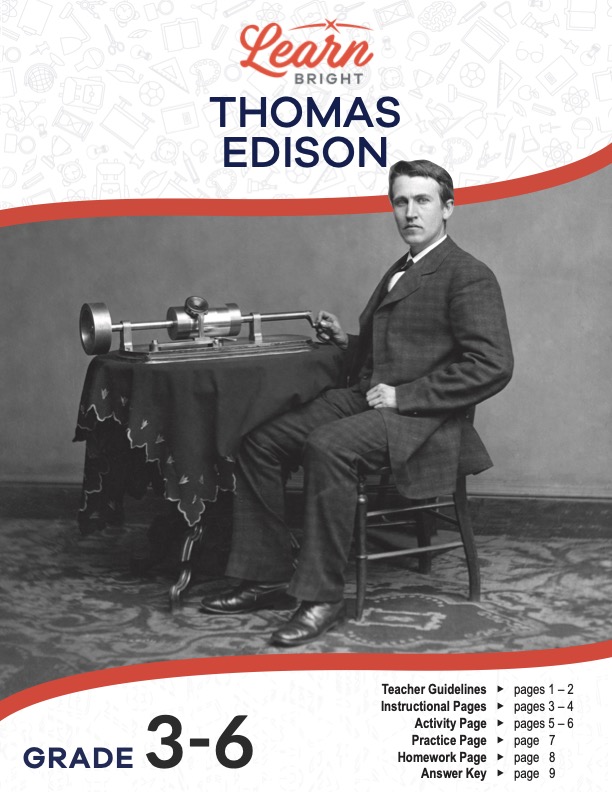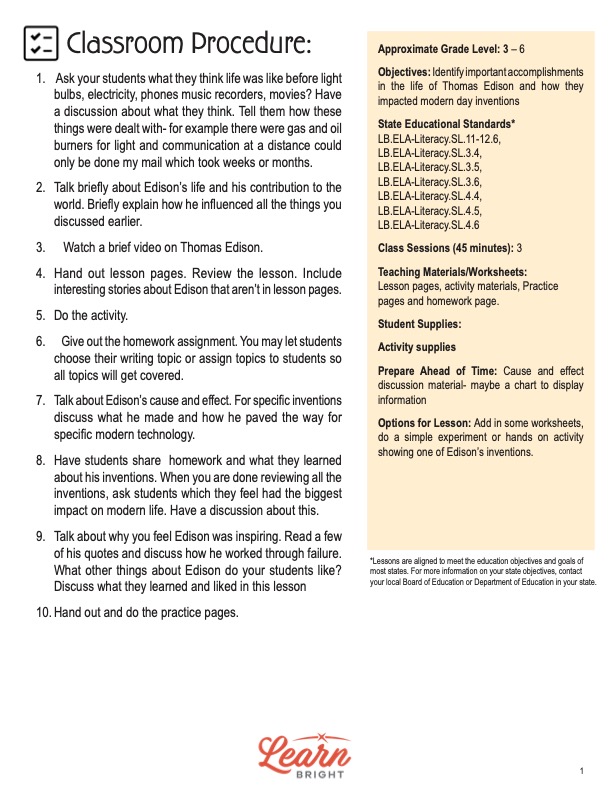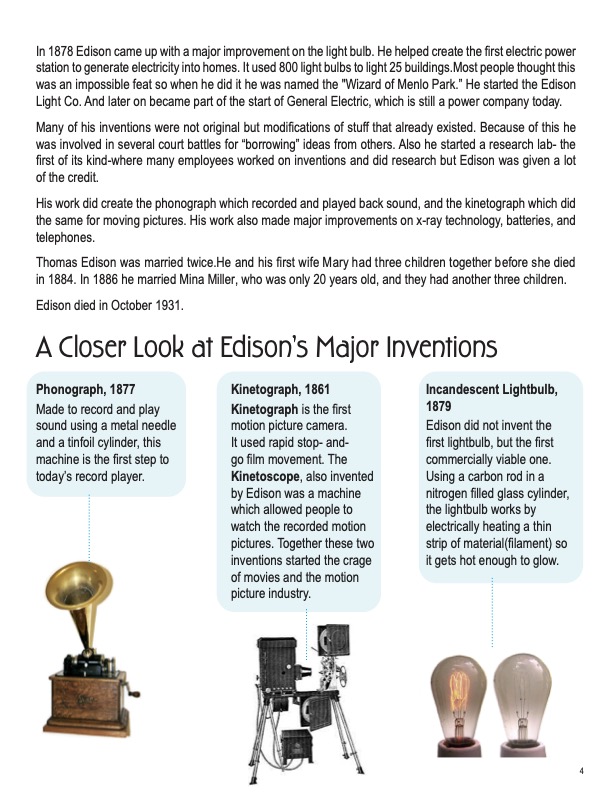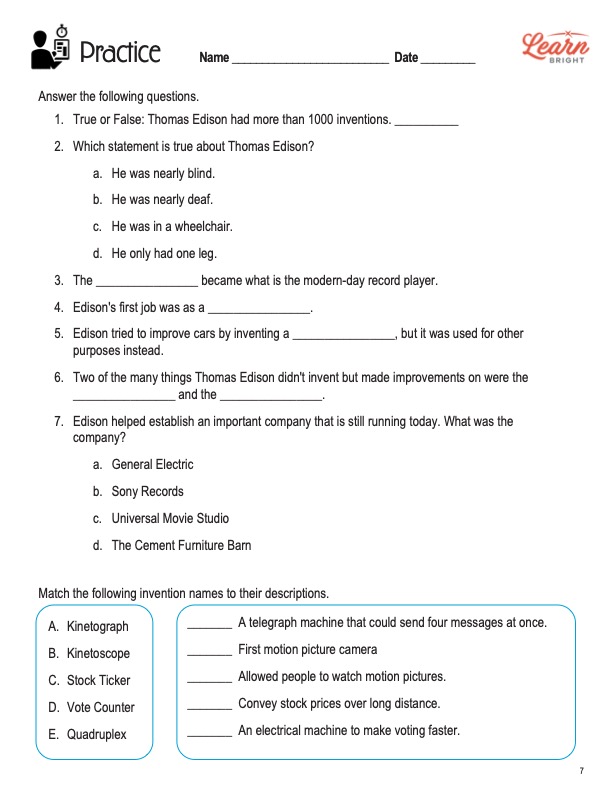Description
What our Thomas Edison lesson plan includes
Lesson Objectives and Overview: Thomas Edison focuses on his inventions and how they have influenced us today. It also spends a little time on how Edison is an inspiring historical figure because he overcame disadvantages and he lived by the idea that failure was a good part of success and to never give up. At the end of the lesson, students will be able to identify important accomplishments in the life of Thomas Edison and how they impacted modern-day inventions. This lesson is for students in 3rd grade, 4th grade, 5th grade, and 6th grade.
Classroom Procedure
Every lesson plan provides you with a classroom procedure page that outlines a step-by-step guide to follow. You do not have to follow the guide exactly. The guide helps you organize the lesson and details when to hand out worksheets. It also lists information in the orange box that you might find useful. You will find the lesson objectives, state standards, and number of class sessions the lesson should take to complete in this area. In addition, it describes the supplies you will need as well as what and how you need to prepare beforehand.
Options for Lesson
Included with this lesson is an “Options for Lesson” section that lists a number of suggestions for activities to add to the lesson or substitutions for the ones already in the lesson. For an additional activity, you could add additional worksheet to the lesson. You could also do a simple experiment with your class to illustrate how Edison’s inventions work.
Teacher Notes
The teacher notes page includes a paragraph with additional guidelines and things to think about as you begin to plan your lesson. This page also includes lines that you can use to add your own notes as you’re preparing for this lesson.
THOMAS EDISON LESSON PLAN CONTENT PAGES
Thomas Alva Edison: A Great American Inventor
The Thomas Edison lesson plan includes two content pages. Before Edison, people lived their lives without telephones, light bulbs, movies, or even electricity. People lit their homes with gas lamps and wrote letters to communicate over long distances, which took weeks or months to deliver. Edison’s goal was to “transform middle class life.” We needed his inventions and improvements to make many modern technologies like movies, phones, light and sound recording, and cement. They even used one of his designs to create the tattoo gun.
Thomas Edison was one of the most important and famous inventors in the history of the United States. He had 1,093 patents for different inventions. That means he averaged one invention every two weeks from 21 years old until he died at 80 years old. He’s the only person to have received a patent every year for 65 years straight. However, not every invention was a success. Several were improvements on other people’s inventions. Many of them made real improvements to the lives of people in the United States.
A History of Thomas Edison
Thomas Edison was born in Ohio on February 11, 1847. He was a poor and shy kid and had Scarlet Fever when he was young. This illness left him almost deaf for the rest of his life. His mother homeschooled him because his teachers thought he wasn’t very smart. His mother taught him how to conduct experiments. At 15, Edison got his first job as an operator for telegraphs.
Edison’s first invention was a vote counter for elections. Congress rejected it and refused to use it, so people thought of it as a failure. Edison later sold a new version of it for $40,000. This was a lot of money at the time, and the money allowed him to become an inventor full time. He also sold his invention of a quadruplex telegraph machine, which could send four messages at once to Western Union.
Then, in 1878, Edison improved the light bulb and helped create the first electric power station which sent electricity into homes. 800 light bulbs lit 25 buildings, which people thought was impossible. People called him the “Wizard of Menlo Park.” He then started the Edison Light Co., which later became a founding part of the company General Electric (which is a power company today).
Many of his inventions were modifications to things that already existed. This led different people to sue him for “borrowing” their ideas. He also started an innovative research lab where employees worked on inventions and conducted research. Edison often got the credit for this work.
He created the phonograph, a device that recorded and played back sound, and the kinetograph, which did the same for moving pictures. He also made improvements on x-ray technology, batteries, and telephones.
Thomas Edison married twice. He had three children with his first wife Mary before she died in 1884. In 1886, he married a woman named Mina Miller, who was only 20 at the time. They had three more children. He died in October 1931.
A Closer Look at Edison’s Major Inventions
Edison created the phonograph in 1877. He created it to record and play sounds using a metal needle and tinfoil cylinder. It was the first version of the record player.
He created the kinetograph in 1861. It was the first motion picture camera. It worked by using rapid stop-and-go film movement. Edison also invented the kinetoscope, which allowed people to watch recorded motion pictures. The two inventions, when used together, started the modern movies and motion picture industry.
Edison also invented the incandescent lightbulb in 1879. He didn’t invent the first lightbulb, but did create the first one that was commercially viable. It uses a carbon rod in a nitrogen filled glass cylinder and electrically heats a thin strip of material (filament) until it’s hot enough to glow.
THOMAS EDISON LESSON PLAN WORKSHEETS
The Thomas Edison lesson plan includes three worksheets: an activity worksheet, a practice worksheet, and a homework assignment. You can refer to the guide on the classroom procedure page to determine when to hand out each worksheet.
TIMELINE ACTIVITY WORKSHEET
The activity worksheet asks students to create a timeline of Edison’s life using historical events that took place during his life. Their timeline should include at least ten events from his life and five events from American history.
MATCHING PRACTICE WORKSHEET
For the practice worksheet, students will first answer questions about the lesson material and then match inventions with their descriptions.
THOMAS EDISON HOMEWORK ASSIGNMENT
The homework assignment asks students to research and learn about one of Thomas Edison’s inventions (from a list provided on the worksheet). They will answer specific questions about the invention. They will also include at least one picture of the invention.
Worksheet Answer Keys
This lesson plan includes answer keys for the practice worksheet. If you choose to administer the lesson pages to your students via PDF, you will need to save a new file that omits these pages. Otherwise, you can simply print out the applicable pages and keep these as reference for yourself when grading assignments.









